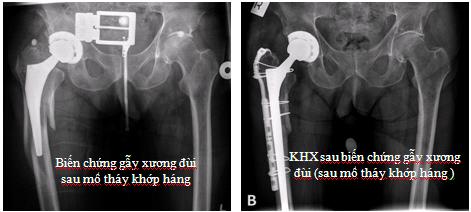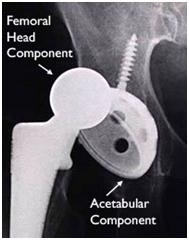Artificial hip replacement is an effective treatment for hip injuries that cannot be conservatively treated. However, there are still undesirable risks and risks.
Possible risks of hip replacement surgery include:
Clogged circuits
An embolism may develop in a venous limb after surgery. This causes very dangerous complications if the blood clot moves to the lungs, heart or brain ... However, to minimize complications on using prophylactic anticoagulants is often prescribed by doctors. In addition, to prevent postoperative thromboembolic complications, precautions are recommended:
Get active early: You will be encouraged to get active early and even practice walking with the exercise frame on the first day after surgery.
Wearing high pressure socks: To reduce the amount of blood in the veins to reduce the risk of embolism.
Nerve damage after hip replacement
There are many risk factors that can lead to nerve damage such as: an inflamed hip joint, a lot of deformity, a bone dysplasia, an obese patient ... To prevent nerve damage in such cases. This requires careful surgery, requiring surgeons with extensive experience in the field of hip replacement.

Complications of femoral fracture after hip replacement surgery.
Infection
Infection can occur at the site of the incision or infection in deeper tissue or in the artificial hip socket. Bacterial infections need to be treated with antibiotics, but deep or intramuscular infections require the removal of an artificial joint.
There is a common cause of infection after hip replacement surgery is bacteria entering the blood through the oral route, through the skin, the urinary tract ... So to prevent infection, before surgery, you need to clean your mouth. Clean, after surgery, you need to have a sterile dressing change to take care of the urinary tract carefully ... You need to notify your doctor as soon as you have one of the following symptoms:
High fever (> 38º5)
Swelling, redness at the incision
Pain and difficulty in movement of the hip joint
Drainage through the incision or drainage leg ...
Fracture
In some cases, the patient may have a fracture of the thigh or hip socket. The proportion of patients with fractures during hip replacement surgery is 0.1-1% (for cement joints) and 3-18% (for non-cement joints). Most fractures occur during the assembly and placement of the cap (Stem).
There are many factors that increase the risk of fractures in surgery such as female patients, osteoporosis, osteoarthritis, non-cement hip replacement (especially in case of long-handle replacement). The fracture is sometimes very small, they can self-heal, but sometimes large fractures need to be adjusted to the anatomical position and then fixed with kirschner nails, steel threads and sometimes even a screw brace, bone graft, or even Even instead of replacing the cymbals ...
Dislocations
The artificial cusp may dislocate from the joint after the joint has been replaced. To avoid this from the first day after surgery, the patient is instructed to place a pillow between the legs while lying down, not close, fold the hip joint more than 90 degrees (squatting) and not cross the legs across the body line. .
If your hip joint is dislocated, your doctor will have to reshape the joint and fix it with a cast or brace for about 4 weeks.

Change in limb length
There are many causes of changing the length of the lateral leg to replace the joint such as: long-term disease that causes damage to many joints, the elbow, tendon spasm, hip joint muscles, complex lesions (in the upper head fracture ) loss of neck markers, femoral transfer nodule, incorrect surgical technique ...
To prevent this complication, it is extremely important to calculate the preoperative conditions and measure joint selection. In the case of a joint replacement of a longer replacement leg causing increased pressure on the joint, the doctor may have to prolong the muscle tendon or in the case of the replacement leg shorter than the healing leg, sometimes this is the cause. muscle weakness around the hip joint; in this case, gradually increasing muscle strength will overcome this limitation. Short cases with few patients can also immediately overcome by changing the thickness of the soles, shoes to balance the two legs ...
Loose joints
Although this complication is uncommon with newly replaced joints, over time the joint gradually loses its stability to the bones and loosens, causing hip pain, pain along the thighbone, making you feel like walking. groggy...
To limit this complication, usually after surgery, you will be advised by your doctor to exercise regimen as well as dietary calcium supplements to limit this complication. However, in case of a lot of loose joints, joint replacement surgery will be performed to solve this problem ...
Reactive inflammatory disease
As a disease caused by the body's immune system response to foreign objects (artificial joints) leading to inflammation around the artificial joint, osteoporosis eventually becomes premature joint fluid. This complication is often difficult to treat. If you find out that you have this complication early, your doctor will give you corticosteroid therapy to treat it, but in the case of little or less effective corticosteroid therapy, your doctor will most likely have to choose another type of joint. to replace you.
In addition to the above complications, some other complications have been recorded such as: wear of the groin joint, pain in the hip joint after surgery (of unknown cause), fracture of the crown ...
Although up to now, hip replacement has also recorded many different types of complications, but the rate is usually not high. You can rest assured because the rate of these complications is decreasing due to many precautions and even when complications occur, the doctor will have solutions to treat appropriately and effectively. .
According to suckhoedoisong











 A12 - 55 - 57 Lê Trọng Tấn, Khu phố Bình Đường 2, Phường An Bình, TP. Dĩ An, Bình Dương
A12 - 55 - 57 Lê Trọng Tấn, Khu phố Bình Đường 2, Phường An Bình, TP. Dĩ An, Bình Dương Điện thoại: 0274.3792 803 - 0274.3790 106 - Số hotline: 0943 508 778
Điện thoại: 0274.3792 803 - 0274.3790 106 - Số hotline: 0943 508 778 medicdian@gmail.com
medicdian@gmail.com www.medicdian.com
www.medicdian.com
